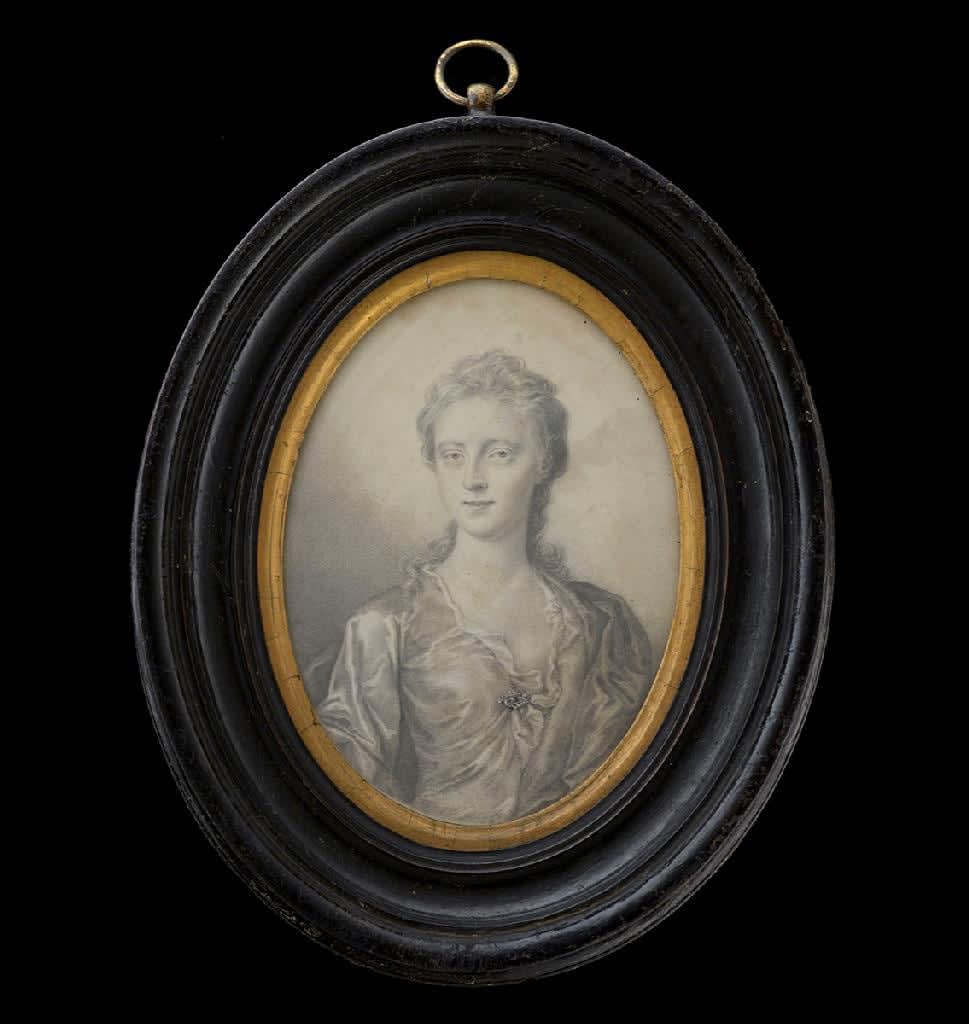
Thomas Forster
Portrait minature of a Lady wearing a satin gown, fastened with a gem-set brooch, and a cloak draped across one shoulder, c. 1700
Graphite on vellum
Oval, 4ins., (105mm) high
Philip Mould & Co.
To view all current artworks for sale visit philipmould.com This plumbago of an unknown lady, drawn by the renowned draftsman Thomas Forster, is typical of the artist’s style at...
To view all current artworks for sale visit philipmould.com
This plumbago of an unknown lady, drawn by the renowned draftsman Thomas Forster, is typical of the artist’s style at the turn of the seventeenth century, with a prime example of his work, almost identical in composition and costume to this portrait, owned by the Metropolitan Museum of Art in New York.
Thomas Forster is known to have reproduced successful compositions popular with his middle-class patrons. Thieme Becker’s encyclopedic Allgemeines Kunstler-lexicon suggests that perhaps this lack of apparent ‘quality’ of sitter can be explained by Forster’s pitch to a level of society more dignified and generally private in character. In terms of technical skill, it has been commented that Forster has never been surpassed. Although this unparalleled level of quality is apparent, his known subjects are rarely of great historical significance.
The origin of the art of plumbago can be traced back to post-restoration England when print makers returned from exile to resume their trade and started to discover an eager market for the originals on which their prints were based. As the art form became more established, artists like Forster found a speciality in producing plumbagos and in fact more or less avoided the print-making process all together. As seen earlier with the likes of Robert White (1645-1703), the plumbago artist understood the importance of line and contrast, making the shift between mediums a natural one, and such artists often reproduced their plumbagos as prints as well as designing title pages and frontispiece pages for books.
By studying Forster’s known works it is possible to glean that he was working for a period of time in Ireland most probably under the patronage of James Butler, 2nd Duke of Ormond (1665-1745), whose many friends and associates seem to have been drawn by the artist including a selection of works now at the Holburne Museum, Bath.
This plumbago of an unknown lady, drawn by the renowned draftsman Thomas Forster, is typical of the artist’s style at the turn of the seventeenth century, with a prime example of his work, almost identical in composition and costume to this portrait, owned by the Metropolitan Museum of Art in New York.
Thomas Forster is known to have reproduced successful compositions popular with his middle-class patrons. Thieme Becker’s encyclopedic Allgemeines Kunstler-lexicon suggests that perhaps this lack of apparent ‘quality’ of sitter can be explained by Forster’s pitch to a level of society more dignified and generally private in character. In terms of technical skill, it has been commented that Forster has never been surpassed. Although this unparalleled level of quality is apparent, his known subjects are rarely of great historical significance.
The origin of the art of plumbago can be traced back to post-restoration England when print makers returned from exile to resume their trade and started to discover an eager market for the originals on which their prints were based. As the art form became more established, artists like Forster found a speciality in producing plumbagos and in fact more or less avoided the print-making process all together. As seen earlier with the likes of Robert White (1645-1703), the plumbago artist understood the importance of line and contrast, making the shift between mediums a natural one, and such artists often reproduced their plumbagos as prints as well as designing title pages and frontispiece pages for books.
By studying Forster’s known works it is possible to glean that he was working for a period of time in Ireland most probably under the patronage of James Butler, 2nd Duke of Ormond (1665-1745), whose many friends and associates seem to have been drawn by the artist including a selection of works now at the Holburne Museum, Bath.
1
of
2